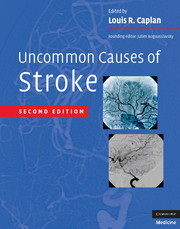Book contents
- Uncommon Causes of Stroke
- Uncommon Causes of Stroke
- Copyright page
- Contents
- List of Contributors
- Preface
- PART I: INFECTIOUS AND INFLAMMATORY CONDITIONS
- PART II: HEREDITARY AND GENETIC CONDITIONS AND MALFORMATIONS
- PART III: VASCULAR CONDITIONS OF THE EYES, EARS, AND BRAIN
- PART IV: DISORDERS INVOLVING ABNORMAL COAGULATION
- 38 ANTI-PHOSPHOLIPID ANTIBODY SYNDROME
- 39 DISSEMINATED INTRAVASCULAR DISEASE
- 40 BLEEDING DISORDERS AND THROMBOPHILIA
- 41 THROMBOTIC THROMBOCYTOPENIC PURPURA
- 42 CEREBROVASCULAR COMPLICATIONS OF HENOCH-SCHÖNLEIN PURPURA
- PART V: SYSTEMIC DISORDERS THAT ALSO INVOLVE THE CEREBROVASCULAR SYSTEM
- PART VI: NONINFLAMMATORY DISORDERS OF THE ARTERIAL WALL
- PART VII: VENOUS OCCLUSIVE CONDITIONS
- PART VIII: VASOSPASTIC CONDITIONS AND OTHER MISCELLANEOUS VASCULOPATHIES
- PART IX: OTHER MISCELLANEOUS CONDITIONS
- Index
38 - ANTI-PHOSPHOLIPID ANTIBODY SYNDROME
from PART IV: - DISORDERS INVOLVING ABNORMAL COAGULATION
Published online by Cambridge University Press: 06 January 2010
- Uncommon Causes of Stroke
- Uncommon Causes of Stroke
- Copyright page
- Contents
- List of Contributors
- Preface
- PART I: INFECTIOUS AND INFLAMMATORY CONDITIONS
- PART II: HEREDITARY AND GENETIC CONDITIONS AND MALFORMATIONS
- PART III: VASCULAR CONDITIONS OF THE EYES, EARS, AND BRAIN
- PART IV: DISORDERS INVOLVING ABNORMAL COAGULATION
- 38 ANTI-PHOSPHOLIPID ANTIBODY SYNDROME
- 39 DISSEMINATED INTRAVASCULAR DISEASE
- 40 BLEEDING DISORDERS AND THROMBOPHILIA
- 41 THROMBOTIC THROMBOCYTOPENIC PURPURA
- 42 CEREBROVASCULAR COMPLICATIONS OF HENOCH-SCHÖNLEIN PURPURA
- PART V: SYSTEMIC DISORDERS THAT ALSO INVOLVE THE CEREBROVASCULAR SYSTEM
- PART VI: NONINFLAMMATORY DISORDERS OF THE ARTERIAL WALL
- PART VII: VENOUS OCCLUSIVE CONDITIONS
- PART VIII: VASOSPASTIC CONDITIONS AND OTHER MISCELLANEOUS VASCULOPATHIES
- PART IX: OTHER MISCELLANEOUS CONDITIONS
- Index
Summary
Keywords
- Type
- Chapter
- Information
- Uncommon Causes of Stroke , pp. 263 - 274Publisher: Cambridge University PressPrint publication year: 2008
- 3
- Cited by

